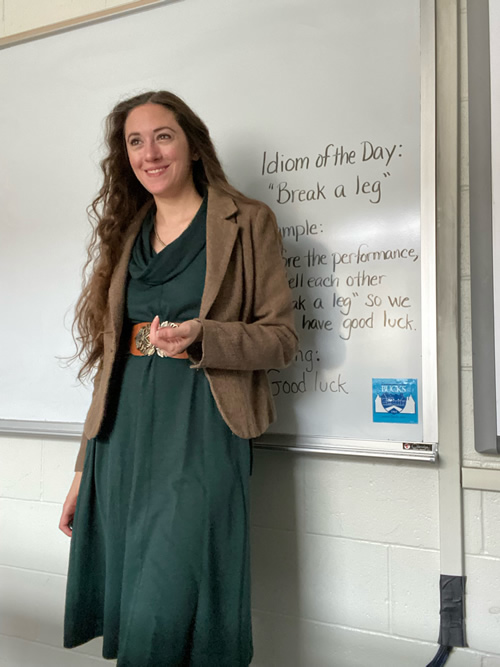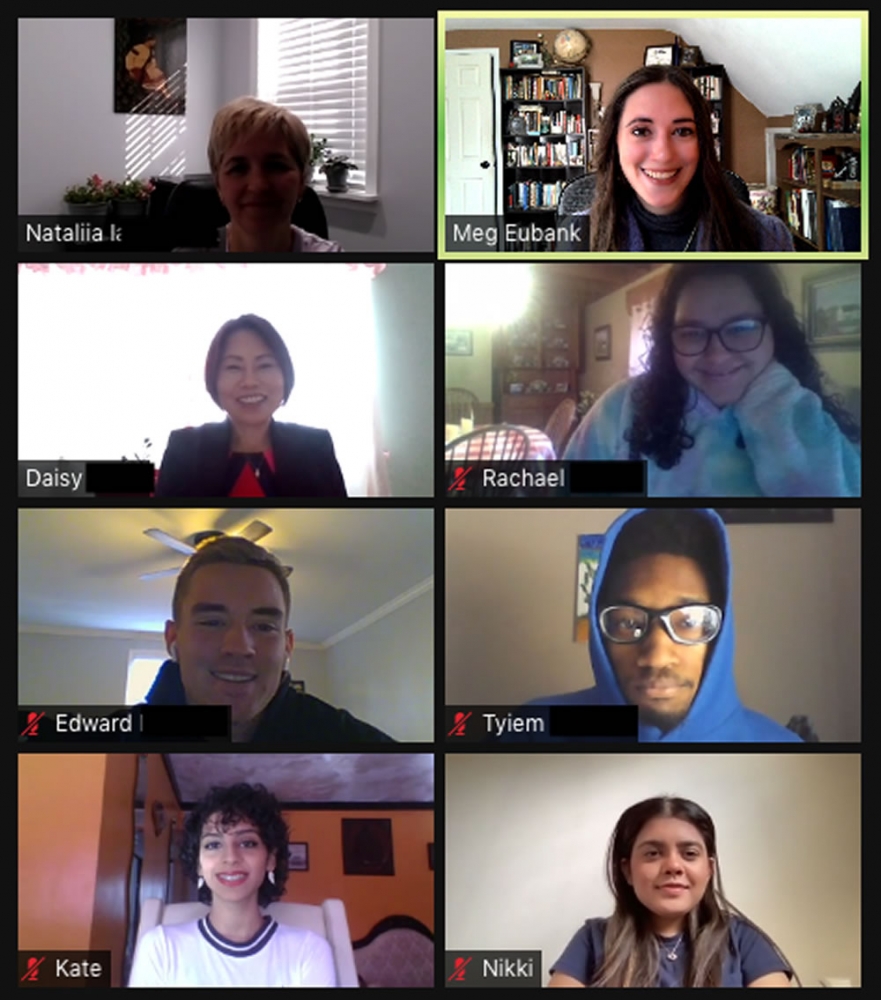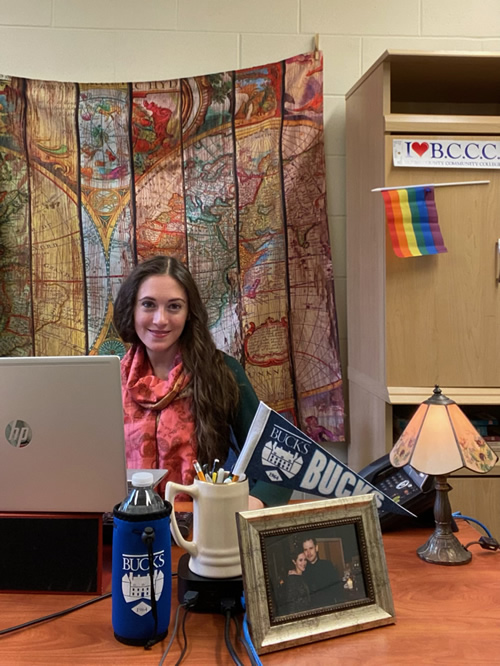Meet Meg Eubank: 2022 TESOL Teacher of the Year
Interview by Fares J. Karam
 The 2022 TESOL Teacher of the Year, Meg Eubank, is
currently a professor at Bucks County Community College in Pennsylvania and a
doctoral student at the University of Houston. Meg has worked with thousands of
diverse people from all over the globe in roles as a college instructor,
nonprofit director, professional tutor, high school teacher, and curriculum
designer.
The 2022 TESOL Teacher of the Year, Meg Eubank, is
currently a professor at Bucks County Community College in Pennsylvania and a
doctoral student at the University of Houston. Meg has worked with thousands of
diverse people from all over the globe in roles as a college instructor,
nonprofit director, professional tutor, high school teacher, and curriculum
designer.
Fares J. Karam, assistant professor of TESOL at the
University of Nevada, Reno, has asked Meg some questions to help us get to know
her.
Congratulations on this award and
important achievement! What does being selected as TESOL Teacher of the Year
mean to you on a professional and personal level?
I am greatly honored and humbled, because there are
many hard working and deserving teachers doing great work during this difficult
pandemic. This recognition is exciting and validating and it inspires me to
keep working to improve my teaching and help others learn the best methods to
work with English language learners. I have to acknowledge, too, the excellent
education I received at my alma mater, Arcadia University, which is where I
learned many skills that I’m being awarded for today, and where my love of
teaching was cemented.
Tell us a bit about how and why you
chose to become a TESOL professional.
My journey to becoming a TESOL professional was an
evolution. I began as an elementary education major and English minor from
Arcadia University who graduated into a hiring freeze during a recession. I was
hired part time in the Tutoring Center at Bucks County Community College as an
ESL (English as a second language) specialist because I was good at explaining
complex ideas simply and teaching English grammar and vocabulary. I had worked
with younger English language learners during student teaching, but really fell
in love with ESL by working with the diverse group of students at the community
college.
In 2011, a coworker told me that a local nonprofit
was looking for people to help teach community English classes to immigrants. I
started working there, and returned to Arcadia University to become certified
in ESL because working with people from all over the globe was incredibly
rewarding and felt like my calling. A decade later, my roles in the nonprofit
had encompassed volunteer, board member, program coordinator, and eventually
executive director when the retiring founder asked me to take over. By 2020, I
had been able to help several thousand students from over 100 countries.
During these years, I continued at the community
college teaching as an adjunct. When the pandemic started, I taught ESL to
international students at a private school, and this year I was brought on as
full-time faculty at Bucks County Community College, where I continue to work
with students from a wide variety of backgrounds.
How did you support your multilingual
students during the pandemic, and what advice do you have to TESOL
professionals looking for ways to support their students via remote learning?
My teaching centers around creating a community of
learners. It is important to me to choose a diverse curriculum that reflects
people from all backgrounds, races, and cultures that is both representative of
my students but also introduces new ideas, as well as vary activities and ways
of presenting information. My biggest challenge during the pandemic was that
many of my students at the private school had returned to their native
countries and were in different time zones! The most difficult task was getting
sleepy teens halfway across the globe to attend class. Virtual learning changed
some of the usual ways we teach.

Meg teaches a Zoom class.
However, whether hybrid, synchronous, or
asynchronous instruction, technology can be an advantage. Some techniques
include breakout rooms on Zoom with small groups, one-on-one conferences, whole
group activities, plus unique experiences like making and sharing videos,
creating a virtual community using social media and digital portfolio tools,
sharing audio clips to converse across time zones, using the chat box in Zoom
to do “waterfalls” of shared ideas, private chatting for students who are not
comfortable asking a question aloud, and ultimately making an inclusive
community with a wide variety of ways to engage. Make sure to present
information verbally, visually, written, recorded, and in as many ways as
possible for students, and implement UDL (universal design for learning)
strategies.
It is also imperative to make sure every student
has equitable access to the tools they need. This year, it was even more
important to use technology and sites students could access, that there was
great flexibility in how students could complete and hand in work, and to offer
alternative ways to do assignments with lots of differentiation. Keep lines of
communication open. I checked in daily with each individual as we learned
authentic and relevant lessons and engaged in a lot of culture sharing to build
a strong community of learners.
 Can you please share some of your
experiences working and leading nonprofit organizations that support
multilingual learners?
Can you please share some of your
experiences working and leading nonprofit organizations that support
multilingual learners?
My work with local nonprofits has centered on a
vision of global family members working together to advocate for themselves and
connect with one another, building community and support. One big challenge is
how to communicate with non-English speakers to inform them of services.
Word-of-mouth does not reach enough people, so it is important to build
partnerships and community. The nonprofit I ran expanded across three counties,
from 150 registrations to 400 a term, serving over 1,000 students every year
and resulting in a 146% increase in enrollment since I began because we built a
strong network in the communities where immigrants were living and working. As
a result, there was incredible support among the immigrants, and we created a
family of people from different countries who offered each other rides to class
and helped one another. If a mother needed to bring her child to class, we
welcomed them. I connected with over 75 community organizations and nonprofits
to hold classes, partner in workshops and services, and connect students to
resources. Beyond academic classes, I initiated working closely with advocacy
groups to make changes at the local, state, and national level, and to empower
people to advocate for themselves.
The best rewards were the goals that my students
reached—a Liberian grandmother who learned to read and write for the first
time; a Mexican victim of human trafficking and sexual abuse that earned her
GED, found a job, and passed her driver’s test; an Eritrean widow with a
toddler son who learned to communicate and navigate her new community; and even
the Chinese seventh grader who suffered from isolation on top of her natural
shyness during the pandemic, but grew into a chatty, creative, productive
student by the end of the school year.
What advice do you have to novice
TESOL colleagues? More specifically, how can they continue to support and
advocate for multilingual learners both inside and outside the
classroom?
The biggest key that opens the door to
compassionate teaching is: Remember that your students are people with complex
feelings and individual goals. I remember a grandmother from China came to
class feeling lonely and isolated, not being able to speak to others in her
community. She studied diligently, and one day walked into class with a big
smile on her face, glowing with happiness. She revealed that she made a new
friend, her neighbor, and had a full conversation in English about their
gardens. She had been craving social interaction with someone her age but
needed to have working proficiency in the same language in order to find that
connection in America. Humans need relationships, and we can help students gain
the tools to connect with others.
Teaching English language learners, we encounter
students from all over the world. As they learn from us, we also learn from
them. Our world becomes larger being exposed to so many different individuals
from all over the globe, but also becomes smaller as we realize that we all
have so much in common. Everyone is concerned with the same worries, like caring
for their families and trying to plan for the future. Our humanity links us in
many ways, and this is essential to remember. The driving forces that everyone
encounters as humans are the same, and ultimately we are all concerned about
our loved ones and trying to do the best we can.
Fares J.
Karam is an assistant professor of TESOL at
the University of Nevada, Reno. His scholarship focuses on the language and
literacy development of multilingual learners from immigrant and refugee
backgrounds. His research has been published in Applied
Linguistics, Research in the Teaching of
English, and TESOL Quarterly—among
others.